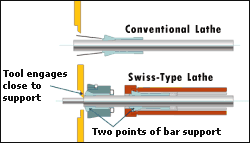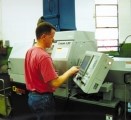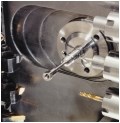Banking On A Swiss-Type
To shops used to conventional turning, the CNC Swiss-type is a strange sort of lathe. But for the right jobs, the machine is worth both the price and the learning curve.
Share



Brendan Slabe had considered buying a CNC Swiss-type lathe for years. And for years, he and others within Slabe Machine Products, a 100-employee job shop in Willoughby, Ohio, decided against it. The machine seemed too expensive for the benefits it could deliver.
"For one-third the price, we could buy a good conventional CNC lathe with a bar feeder," Mr. Slabe says. "Put that machine next to a machining center, and we could replicate any work a CNC Swiss-type could do for far less cost."
That's what he thought, anyway. Then, last year, his shop landed a job that seemed ideal for a CNC Swiss-type, so the shop decided to take a chance. The company's first CNC Swiss-type landed on the shop floor. "That's when we saw what we had been missing," he said.
Make no mistake, the CNC Swiss-type is a niche machine. The only parts well-suited to it are—to generalize—long, small, complex, and produced in small quantities. However, for turned parts that do fit this description, Slabe Machine now realizes productivity far surpassing what it could achieve on any competing process, including a lathe and machining center in sequence. Mr. Slabe points to two basic reasons why.
One is the faster metal removal the Swiss-type makes possible. The defining characteristic of a Swiss-type lathe is a moving headstock that keeps the workpiece always supported near the point of tool contact. The resulting rigidity lets Slabe Machine cut to higher depths on the Swiss-type than it can with other comparable lathes, without sacrificing tool life or precision.
But the more significant reason for higher productivity is the reduced part handling. When trying to justify a CNC Swiss-type machine in the past, Mr. Slabe routinely underestimated just how much reduced handling would save him. He underestimated it, he says, because it is so difficult to gage how much money and time are truly lost to any manual setup. Removing partially completed parts from one machine and loading them on the next machine is an operation fraught with opportunities not only for human error— potentially leading to scrapped parts—but also human delays. The setup and loading themselves are time-consuming enough. But all-too-common is what Mr. Slabe calls "walking-around time,"when an operator has to coordinate with someone else in the shop. Whether the reason is a first article inspection, or some unexpected problem like a batch that is missing a few pieces, the operator has to seek out the coworker who can help him, then wait at least until that coworker can put down whatever he is working on at that moment. And all this time, a machine is sitting idle.
The CNC Swiss-type lathe pays its way in part by eliminating these delays. It machines a complex part complete without stopping for mid-process handling. In addition, it keeps on making parts, without interruption, for as long as the bar stock lasts.
Swiss Basics
Here is what makes a Swiss-type lathe different: Z-axis motion comes from the workpiece feeding, not the tool. The tool moves in X—the radial direction—but not in Z, the direction parallel to the workpiece axis. In this direction, the workpiece is forced past the tool by a sliding headstock mechanism.
Contrast this approach with that of a conventional lathe having a fixed headstock. For example, turn a part chucked at one end and free at the other, and the tool engaging the workpiece in different places will see different degrees of support. As the tool moves away from the chuck toward the free end, workpiece deflection increases, potentially reducing tool life, accuracy, and surface quality.
The Swiss-type mechanism lets an OD tool always engage the part just a fraction of an inch from the guide bushing's support. This is true of an OD turning tool or a live tool. The stability that results lets the Swiss-type machine long parts—those with length-to-diameter ratios of 4:1 or greater—far more aggressively than other comparable lathes, without any loss to tool or tolerance.
There are some limitations. One is that the Swiss-type design makes it all but impossible to take multiple turning passes over the same area. Once the workpiece has been fed out, there is little freedom to retract it again. As a result, there is generally no sequence of rough, semi-finish, and finish in Swiss-type turning. Instead, these cuts must be made to finish depth.
Another limitation is that a Swiss-type machine must be sized to the job. A conventional lathe can machine workpieces in as wide a range of sizes as its chuck will permit. But on any given Swiss-type machine, the range is more narrow. The work- piece must be fed through a guide bushing, and this guide bushing is only so big. A Swiss-type machine designed to run 0.75-inch bar stock can run smaller stock than this, but nothing larger.
Typically a "done-in-one" machine, a CNC Swiss-type, generally offers live tools, a subspindle, and a tool turret for back-face operations. Some conventional CNC lathes also offer all of these features. However, the CNC Swiss-type doesn't compete with these conventional lathes for single-setup work. The two machine types excel at different classes of parts. Instead, the CNC Swiss-type competes with multiple-setup processes, where turned blanks for complex parts may be machined on a simple CNC lathe or a multispindle automatic, then sent to a machining center, drilling machine, or some other subsequent station for critical follow-up operations.
Justification
Indeed, multi-setup processes were the competition for the CNC Swiss-type in Mr. Slabe's mind. Historically a multispindle automatic shop, Slabe Machine was accustomed to processes in which milled or cross-drilled features are cut on follow-up machines. In years past, jobs requiring this follow-up work made up a smaller portion of the shop's work-load. However, as the shop began to pursue steadily more high-end work, it found itself taking on more complex parts requiring follow-up operations. And the costs of mid-process handling—errors and delays—were eating into profitability. "A one-stop process was looking more attractive," Mr. Slabe says.
The shop purchased its first CNC Swiss-type lathe last year. The model the shop chose, from Marubeni Citizen-Cincom (Allendale, New Jersey), accommodates bar stock up to 25/32 inch.
Mr. Slabe says it was more than just a desire to machine more complex parts that made it time to try the CNC Swiss-type. If this was the only argument in the machine's favor, he never could have justified it. However, two other trends the shop is seeing also affect the value of this machine. They are trends almost any screw machine shop will recognize: shrinking batch sizes and a shrinking pool of skilled machinists.
At Slabe Machine, customer emphasis on just-in-time delivery has the shop shipping jobs in smaller batch sizes all the time. This shrinkage erodes profitability when a new batch requires a new setup on a screw machine. At the same time, Mr. Slabe describes operators skilled at performing these more frequent screw machine setups as "free agents," whose skills now command a premium.
The CNC Swiss-type addresses both issues. Small batches are no problem. Because changeover from one job to the next is a relatively quick and simple exercise (possibly as simple as just loading a different program), the CNC Swiss-type can run small batches economically.
At the same time, the machine does not require a skilled operator to attend it. So long as the bar stock lasts, the machine can keep producing parts without any human service.
But these benefits come at a cost. And for Slabe Machine, there was more than just the purchase price. Starting out with one of these machines in a shop that had no CNC Swiss-type experience involved another kind of investment, too.
Different Thinking
The added investment is the learning curve. "We're still climbing that curve," Mr. Slabe says.
The shop hired a new programmer/operator for its new machine because of his experience with programming CNC Swiss-types. Doug Paoletta, who has also programmed conventional CNC lathes, speaks to the differences between the two. "The Swiss-type forces you to think differently," he says.
A major difference is the need to take turning cuts at full depth instead of making multiple passes. This demand of a Swiss-type machine changes the way the programmer thinks about a process that isn't holding tolerance. On a conventional lathe, one way to achieve a more accurate process might be to take a deeper semi-finish pass in exchange for a lighter finishing cut. On a Swiss-type, an approach like this generally is not an option. However, an alternative may come from the subspindle, which on a Swiss-type is as much of a support device as it is a mechanism for back-face operations. For long work demanding more rigid holding, the subspindle can be programmed to "swallow" the part to a greater depth, and continue swallowing the part at ever deeper increments as the bar feeds out.
Some differences are even more fundamental. Perhaps chief among these is that the equivalent to a positive Z-axis move on a conventional lathe is a negative Z-axis move on a Swiss-type. Certain commands in G-code also take on a different meaning in Swiss-type programming. This is important primarily because a CNC Swiss-type is typically programmed manually. "And manual programmers tend to write code from memory," says Mr. Paoletta. "So you don't want any programmer switching back and forth between conventional and Swiss-type machines. It's too easy to make a mistake."
Mr. Paoletta is now training another programmer/operator for Slabe Machine's CNC Swiss-type. These two operators will man the machine through two shifts. But if and when a second machine comes, it is likely that no operators other than these two will be necessary to make it productive. And this is perhaps the most significant difference between the CNC Swiss-type and other machines this shop has known. The operator who performs the basic tasks necessary to keep one CNC Swiss-type making parts can, while the first machine is cutting, perform these same tasks for the next machine like it—and maybe also for the next machine after that.
In other words, now that Slabe Machine has ramped up with one CNC Swiss-type, an additional CNC Swiss-type can deliver even greater returns.
CNC Swiss-Type Application #1
Slabe Machine produced this part before it bought the CNC Swiss-type, but now produces the part more economically on the Swiss-type machine.
The old process involved three separate machines, creating an opportunity for delay and error at each point where the part had to be transferred from one machine to the next.
Material: 400 grade stainless
Length: 2 inches
Initial stock: 5/16 inch diameter
Old process:
- Cut off blanks on a small pin lathe at 200 per hour.
- Grind stem to 0.100 inch depth at 40 per hour.
- Cross drill and chamfer 0.0150 inch hole at 75 per hour.
New process with CNC Swiss-type: Machine the part complete at a rate of 45 per hour.
CNC Swiss-Type Application #2
Here is another part Slabe Machine now produces more economically on the CNC Swiss-type, thanks to reduced handling. Material: 300 grade stainless
Length: 5/8 inch
Initial stock: 1/4 inch diameter
Old process:
- Turn blanks on a multispindle automatic at 250 per hour.
- Turn 0.0005-inch tolerance stem on single-spindle automatic at 175 per hour.
- Gun drill 0.100-inch diameter axial through-hole (not visible) and chamfer both ends at 60 per hour.
- Broach hex flats at 50 per hour.
New process with CNC Swiss-type: Machine the part complete at a rate of 45 per hour.
Why This Part Went Back To A Conventional Lathe
One of the advantages of the CNC Swiss-type design is workholding stability. For the titanium part shown, this stability permitted higher depths of cut than had been achieved on a conventional lathe. However, the shop has since moved this part back to the conventional lathe. The shop found a way to make heavier cuts practical on non-Swiss-type machines, and in the case of this part, the change tipped the economical scales back in favor of conventional turning. According to Brendan Slabe, the key was high pressure coolant. And the shop recently made high pressure coolant more economical for itself with a tooling accessory the shop developed for its own use, but is now marketing to other shops.
Previously, tool wear and tool failure were the obstacles to heavier turning. However, on many of Slabe Machine's jobs, high pressure coolant has let the shop overcome these obstacles by slowing the rate of tool wear enough to permit the heavier cuts. Mr. Slabe credits the longer life to the high pressure stream breaking up chips, cooling the cutting zone, and reducing the likelihood of a chip welding to the tool.
The shop now uses high pressure coolant in the range of 1,000 to 3,000 psi during conventional CNC turning. However, just a high-pressure pump is not enough, says Mr. Slabe. The resulting coolant stream also has to be directed toward the cut, not just flooded over the workzone.
One solution is to use a special toolholder designed to channel the coolant. However, Mr. Slabe's less expensive solution was to develop a bolt-on attachment that can be used with an existing low-cost lathe toolholder. Mr. Slabe now calls his invention "MaxCool," and he hopes to sell MaxCool attachments to other shops interested in turning with high pressure coolant.
Related Content
4 Tips for Staying Profitable in the Face of Change
After more than 40 years in business, this shop has learned how to adapt to stay profitable.
Read MoreOrthopedic Event Discusses Manufacturing Strategies
At the seminar, representatives from multiple companies discussed strategies for making orthopedic devices accurately and efficiently.
Read MoreHow to Successfully Adopt Five-Axis Machining
While there are many changes to adopt when moving to five-axis, they all compliment the overall goal of better parts through less operations.
Read More4 Commonly Misapplied CNC Features
Misapplication of these important CNC features will result in wasted time, wasted or duplicated effort and/or wasted material.
Read MoreRead Next
OEM Tour Video: Lean Manufacturing for Measurement and Metrology
How can a facility that requires manual work for some long-standing parts be made more efficient? Join us as we look inside The L. S. Starrett Company’s headquarters in Athol, Massachusetts, and see how this long-established OEM is updating its processes.
Read More



































